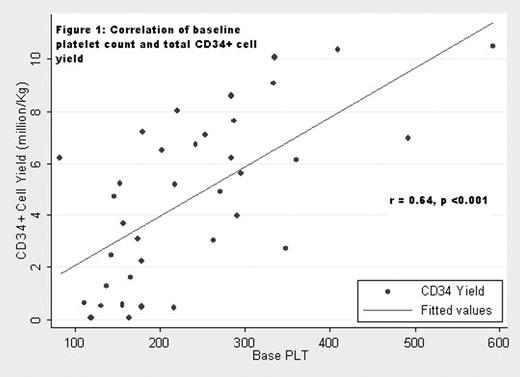Abstract
Background: Previous studies have proposed combination of various factors that predict poor mobilization after GCSF stimulation. However, there is no single clinical or laboratory test that reliably correlates with bone marrow reserve and PBPC mobilization. Peripheral blood CD34+ cell count (pCD34) reliably correlates with PBPC mobilization and yield but only after GCSF administration.
Methods: We have prospectively followed 36 autologous PBPC transplant candidates, from the time of initial evaluation to transplant, to evaluate factors the correlate with bone marrow reserve and autologous PBPC mobilization.
Results: The patients median age was 63 (range 26 – 76). 21 of the 36 patients were diagnosed with dysproteinemia, primarily multiple myeloma, 10 patients had non-Hodgkin’s lymphoma while the remaining 5 had other form of hematological malignancies. Our evaluation shows baseline platelet count prior to growth factor administration significantly correlate with total CD34+ cell yield (spearman: r = 0.64, p <0.001, Figure 1). In addition, daily platelet count during PBPC harvest correlate with CD34+ cell yield for the day (spearman: r = 0.6, p <0.001). Using multiple linear regression model (F = 19.1, p <0.001, R2 = 0.64), we have determined patients’ age (p = 0.03) and type of disease (p <0.001), in addition to platelet count (p<0.001), significantly correlate with total CD34+ cell yield. Further analysis showed low baseline platelet count predicts poor PBPC mobilization. Using Receiver Operating Curve (ROC), we have determined that platelet count of 174,000/ul was the best cut-off for collecting at least 2 million/Kg CD34+ cells with sensitivity of 81% and specificity of 78% and estimated correct classification of 81%. Even though pCD34 counts were slightly more sensitive and were better at identifying poor mobilizers in our cohort (best cut-off 10/ul, sensitivity 96%, specificity 67%, correct classification 89%), their clinical utility were diminished since the values were only known after GCSF administration.
Conclusion: Baseline platelet count is a sensitive predictor of bone marrow reserve and can be used prior to growth factor administration to predict poor mobilization.
Author notes
Corresponding author


This feature is available to Subscribers Only
Sign In or Create an Account Close Modal